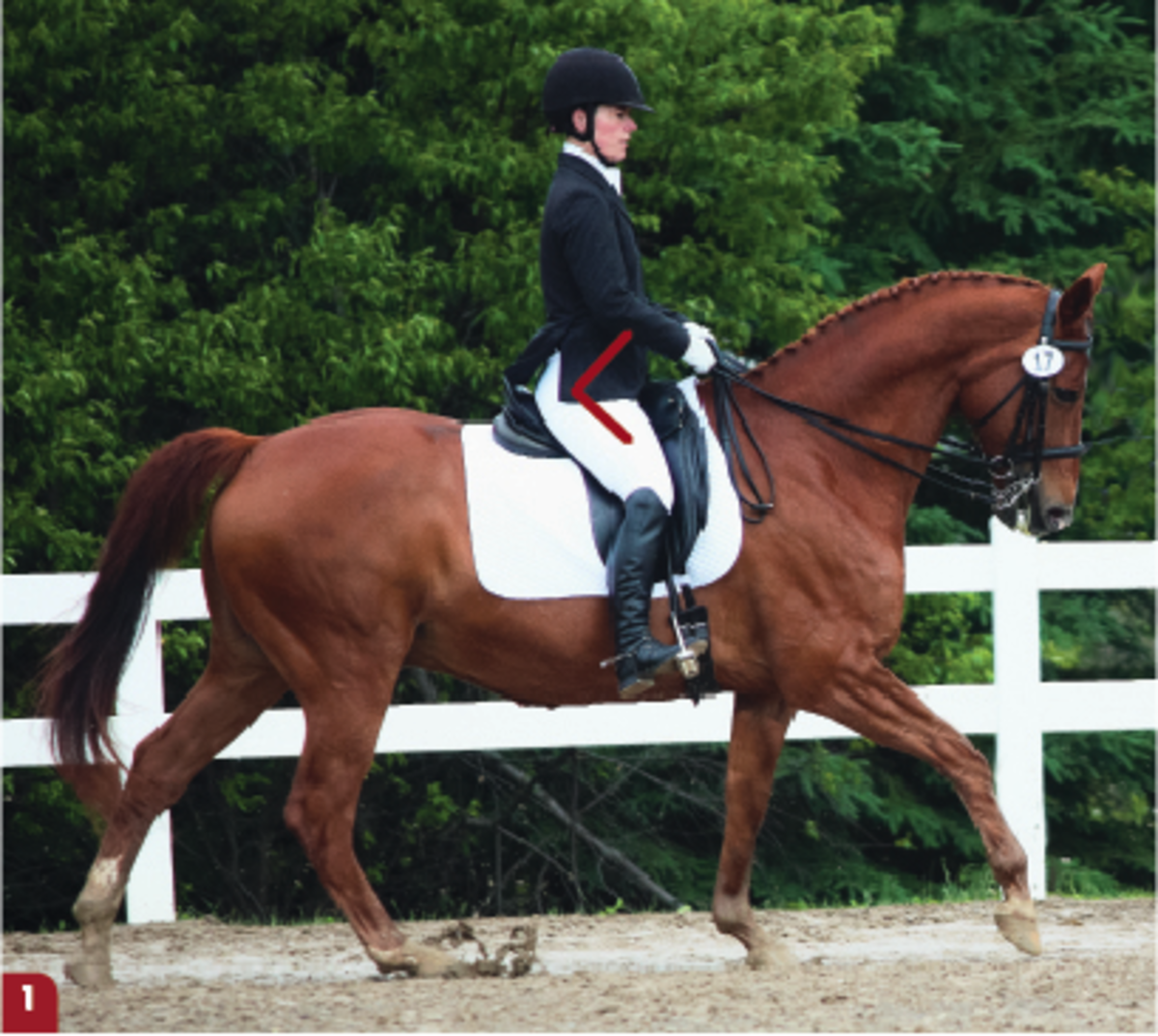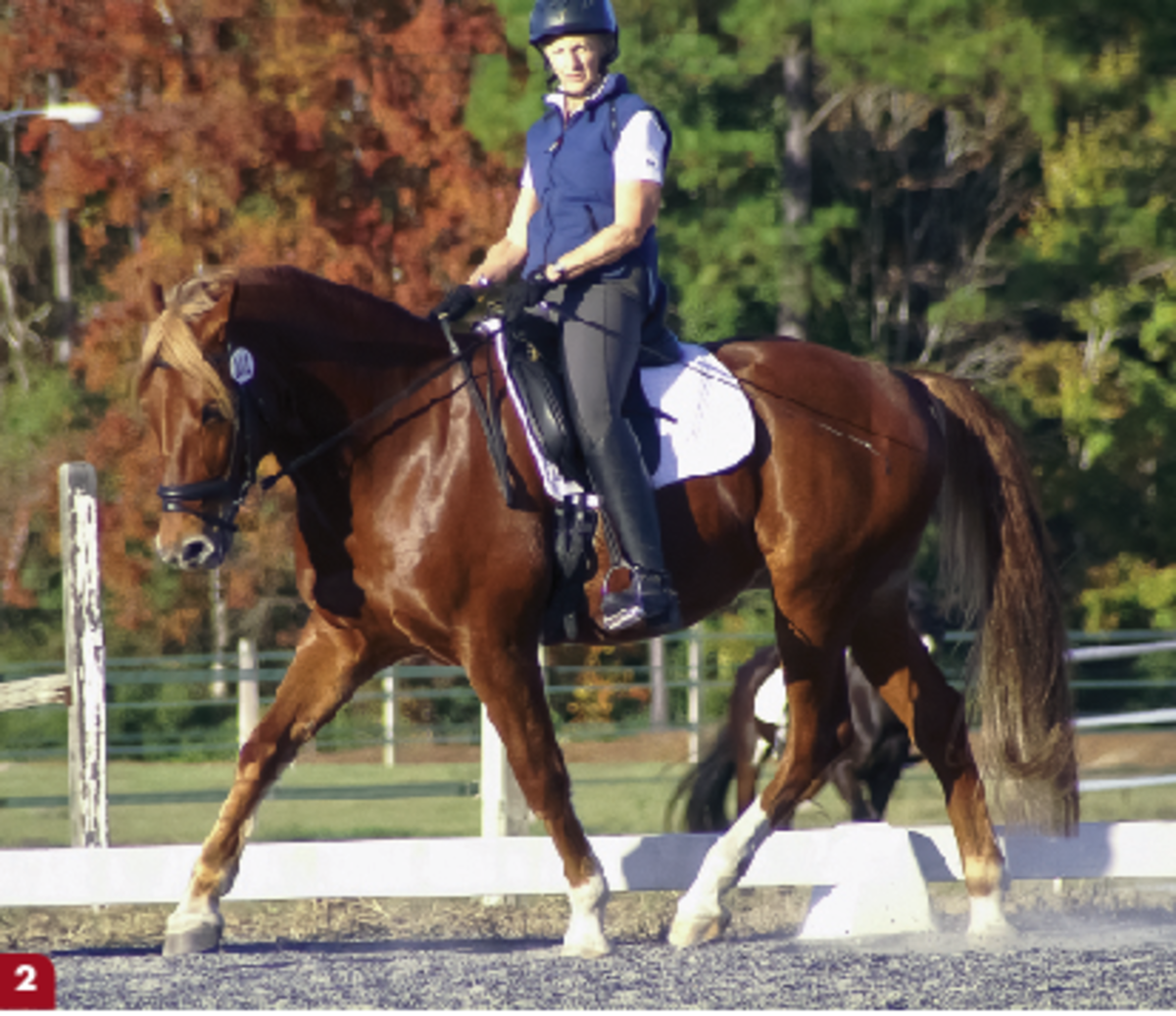
Our first pair is Meaghan Dalley and Wigorello, her Hanoverian gelding. The pair is showing Third Level in this photo and they school Fourth Level at home. Here we see Wigorello cantering in an uphill frame with a nice arch showing in the topline of his neck. As I have mentioned previously in my column, taking good photos of a horse in canter is not easy, as each phase shows a different moment of balance. This photo shows Wigorello in the middle of the landing phase, when he has the diagonal (inside hind and outside front) pair on the ground. The outside hind is just lifting off and the inside front has not yet landed. In this phase the horse’s back is less round and deeper. (This is the moment the rider feels that she sits the deepest in the horse.)
Meaghan’s upper body is nicely upright, above her pelvis, and she is looking straight ahead. Her upper arms appear relaxed at her sides. If you were to draw a line from her elbow to her hand to her horse’s mouth, you would find that it is perfectly straight. To perfect the picture, I would encourage Meaghan to turn her right hand more upright, which would allow for more elasticity and help soften the contact even more.
Analyzing her seat closely, I notice that her hip joint is not truly open. The two red lines in the photo, which illustrate the angle of Meaghan’s upper leg and pelvis, make this more obvious.
Interestingly, Meaghan’s leg is nicely elongated and her heel is down correctly. I say this because people that have short hip flexors, or who find it difficult to stretch their legs straight down, will often keep their upper legs more bent. Commonly, their knees will slide up against the knee roll. Meaghan, on the other hand, shows the opposite problem: Her upper leg has stayed correctly in place, but her pelvis is tilting incorrectly forward.
Meaghan’s position makes it a bit harder to influence her horse’s hind legs with her seat, and she does not encourage him enough to step under her weight. This can make riding dressage in higher collection and executing clean flying changes more difficult, because the horse is not stepping properly with his hind leg.
Of course, I cannot tell from this one photo if Meaghan is struggling with higher collection and/or flying changes, but it is an important connection I want to explain in more detail in case it is a problem she, or any of the readers, are working through.
Try this: In walk, work on feeling the entire length of your seat bones on the saddle. Our seat bones are not just two bones that point down (see, for example, the illustration in chapter three of my book, Balance in Movement). Rather, they are broad at the rear and meet in the pubic area—forming an opposite-shaped “V.” So when we are sitting on our seat bones, we sit over a triangular-shaped base with the tip of the triangle in front. As they are shaped like a sleigh, you can rock forward and back on them. (You can also try this while sitting in a chair.)
This means that the further forward you lean, the narrower your seat becomes. The further backward you lean, the wider the area on which your weight is distributed.
After feeling that your seat bones are not one fixed point where you just stay put in the saddle, try to keep your upper body quiet and upright while moving your pelvis.
While riding, try to keep your legs relaxed and quiet as you work through this exercise. Notice how the movement of your pelvis always creates movement in your hips and lower back. Tilting your pelvis forward opens your hips and rounds your lower back, while tilting it backward closes your hips and hollows your lower back. An upright, balanced seat allows you to tilt your pelvis, open and close your hips and adjust your back with much less effort.
To help Meaghan open her hips and become longer in her lower back, she can imagine that her lower abdominal muscles help lift weight off her pubic bone so that the ends of her seat bones feel a bit deeper in the saddle. Her seat muscles (buttocks) should stay open and relaxed, not pushing the pelvis upward.
This slight increase in activity in her lower abdominal muscles also will help to stabilize her core and free her seat to be quicker in those movements that require a higher degree of collection. Remember that collected does not mean slow. Count the number of canter strides down a line in a working canter, then count the number down the same line at collected canter. The collected movement allows more strides in the same distance. Speeding up the horse’s hind legs while slowing down the tempo is the key to good collection, so a rider must be able to move her seat quickly yet accurately.
I hope that this is helpful for her and wish her good luck and happy rides on her way up to Fourth Level.
Photo 2: The Senior Rider

This photo of Emily Hickey and Novio, her 8-year-old Andalusian cross, shows the pair riding Training Level at a local schooling show.
Emily is 63 years old and has been riding for only six years. Kudos to her, as learning to ride when one is not so young is quite a challenge. My father used to say, “The human lifetime is too short to become a decent rider.” But, on the other hand, riding is one of the few sports that can be learned and performed later in life, too!
My first impression, when looking at the photo, is that I notice Emily has very long and well-placed legs—something even younger riders will envy her for. Many late beginners have tension around the hip joints and cannot manage to ride with such a long and supple leg position. Having long legs and a shorter upper body gives Emily an easier natural balance on a horse because her center of gravity is lower than people who have the opposite build.
One catch to Emily’s balance is that when influencing her horse with her weight aids, she may need to make bigger movements than someone who has a longer torso and, therefore, a higher center of gravity.
Emily shows a slight roundness in her shoulders, and I notice some tension in her lower arm. She is looking in the direction she wants to turn and, as a result, is turning her head too much. This can cause an imbalance in her seat. Yes, it is often a good tip to look in the direction you are riding, but your head shouldn’t turn so far that you can’t look through your horse’s ears.
I also notice tension in Emily’s left lower arm muscles. Her fingers are open and her wrists are turned down to hold her reins. Her whip is placed correctly over her thigh, but she is holding it mainly with her little finger. This causes tension in her lower arm and stiffens her wrist.
Try this: It is not easy to stay supple in the wrist when organizing the reins and whip in your hand. Place a rubber martingale stopper on your whip so that when you rest the whip the stopper lays on top of your hand. This will help hold the whip in place so that you do not need to worry so much about tightly gripping it while trying to manage your reins.
Try this: One last thing I would recommend as an exercise for Emily is a good tip for anyone: Turn your upper body inside and outside while riding a straight line. Feel that your balance is not changing as you do this. The rotation within your upper body will help to build more length and stability around your core and make your influence in the saddle clearer to your horse.
In the photo, Emily’s nice harmony with her horse is an encouragement for everyone. Learning and achieving lightness and harmony in riding is possible at any time in our lives. It is never too late!
Wishing her good luck on her journey with the horses.
This article originally appeared in the May 2014 issue of Dressage Today. If you would like to send your photo for critique, please submit a high-resolution image (300 dpi and 4 by 6 inches in size) to DressageToday@aimmedia.com. Turnout in dressage show or clinic-appropriate attire is encouraged. Don’t forget your helmet!











